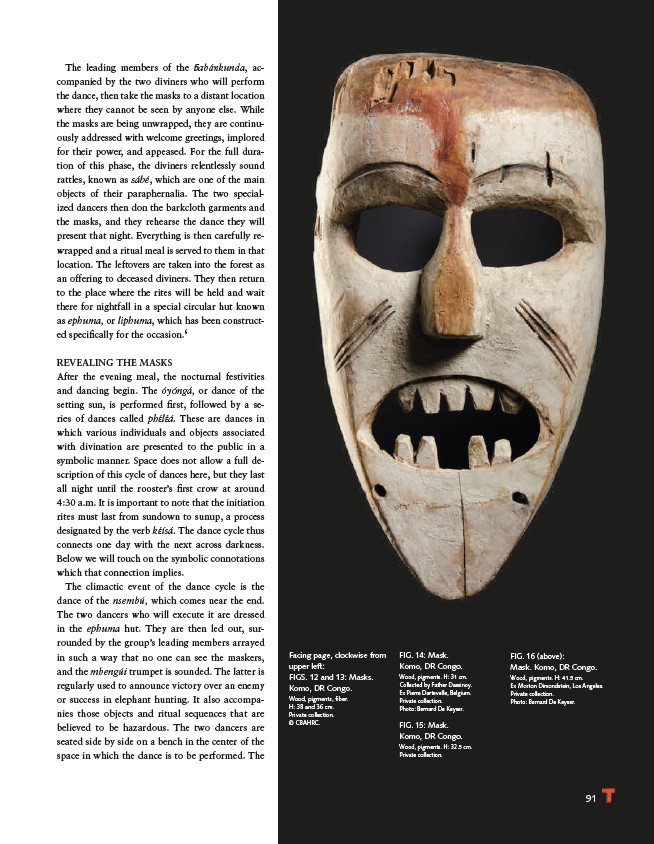
91
Facing page, clockwise from
upper left:
FIGS. 12 and 13: Masks.
Komo, DR Congo.
Wood, pigments, fiber.
H: 38 and 36 cm.
Private collection.
© CBAHRC.
FIG. 14: Mask.
Komo, DR Congo.
Wood, pigments. H: 31 cm.
Collected by Father Dassinoy.
Ex Pierre Dartevelle, Belgium.
Private collection.
Photo: Bernard De Keyser.
FIG. 15: Mask.
Komo, DR Congo.
Wood, pigments. H: 32.5 cm.
Private collection.
The leading members of the ƃabánkunda, accompanied
by the two diviners who will perform
the dance, then take the masks to a distant location
where they cannot be seen by anyone else. While
the masks are being unwrapped, they are continuously
addressed with welcome greetings, implored
for their power, and appeased. For the full duration
of this phase, the diviners relentlessly sound
rattles, known as sábé, which are one of the main
objects of their paraphernalia. The two specialized
dancers then don the barkcloth garments and
the masks, and they rehearse the dance they will
present that night. Everything is then carefully rewrapped
and a ritual meal is served to them in that
location. The leftovers are taken into the forest as
an offering to deceased diviners. They then return
to the place where the rites will be held and wait
there for nightfall in a special circular hut known
as ephuma, or liphuma, which has been constructed
specifically for the occasion.6
REVEALING THE MASKS
After the evening meal, the nocturnal festivities
and dancing begin. The óyóngá, or dance of the
setting sun, is performed first, followed by a series
of dances called phέlέá. These are dances in
which various individuals and objects associated
with divination are presented to the public in a
symbolic manner. Space does not allow a full description
of this cycle of dances here, but they last
all night until the rooster’s first crow at around
4:30 a.m. It is important to note that the initiation
rites must last from sundown to sunup, a process
designated by the verb kέísá. The dance cycle thus
connects one day with the next across darkness.
Below we will touch on the symbolic connotations
which that connection implies.
The climactic event of the dance cycle is the
dance of the nsembú, which comes near the end.
The two dancers who will execute it are dressed
in the ephuma hut. They are then led out, surrounded
by the group’s leading members arrayed
in such a way that no one can see the maskers,
and the mbengúi trumpet is sounded. The latter is
regularly used to announce victory over an enemy
or success in elephant hunting. It also accompanies
those objects and ritual sequences that are
believed to be hazardous. The two dancers are
seated side by side on a bench in the center of the
space in which the dance is to be performed. The
FIG. 16 (above):
Mask. Komo, DR Congo.
Wood, pigments. H: 41.5 cm.
Ex Morton Dimondstein, Los Angeles.
Private collection.
Photo: Bernard De Keyser.